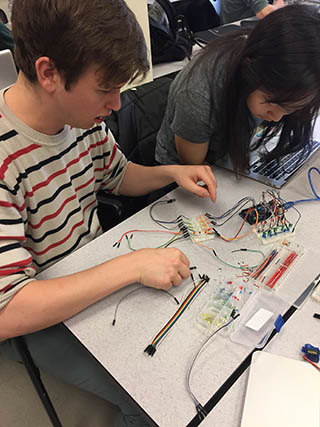Summary
Over the course of the class students are introduced to various electronic components such as, actuators: DC motors and servos; sensors: Temperature, humidity, clap, knock, IR, moisture, flame, motion; LEDs, buttons and so on, that can be interfaced with Arduino.
Instructors demonstrate and explain the basic purpose of each of these components and walk them through the specific software library that is used to incorporate such hardware in their code. Instructors can use the Arduino website to see more class videos and tutorials.

Students work on prototyping their Arduino project. (Courtesy of MIT OpenCourseWare.)
Purpose
We believe it is important for students to learn that creativity, especially in highly technical fields, often stems from extending and expanding on the work of someone else. Many students will believe that what they create is not creative if it is not completely novel, it is important to encourage students to set this philosophy aside for this class, since we are learning a new technology and will learn together by putting our own unique twist to other creative projects already showcased online.
Logistics
After hearing about collaboration and having to learn the GitHub workflow, students are often a bit introverted and need some encouragement to become social again and to find a partner for this activity. We employ improv activities for this when needed.
Once students pair up, they are usually very self-managing in deciding on a modification and executing it together. It can be helpful to walk around and jump into each team to ask them about their modification and model collaborative brainstorming and troubleshooting to ensure they are moving in a positive direction.
